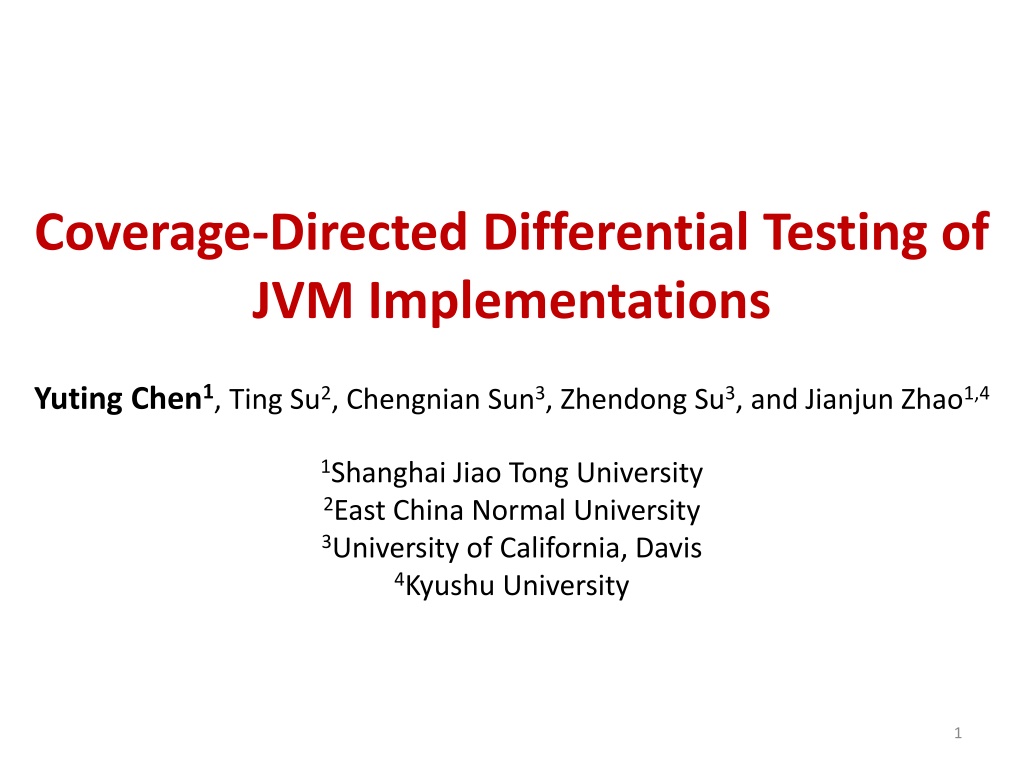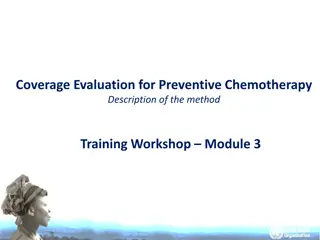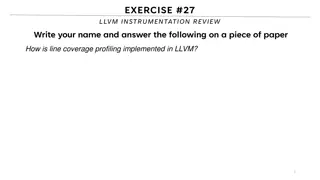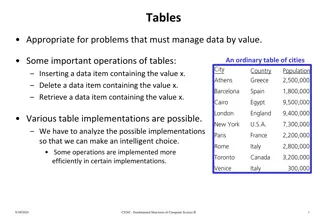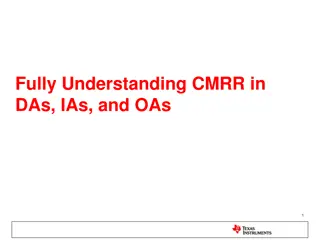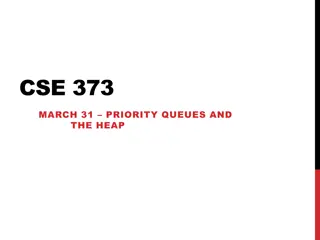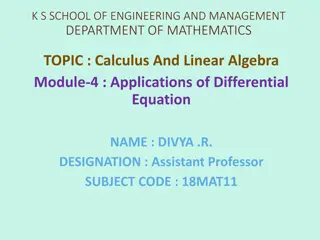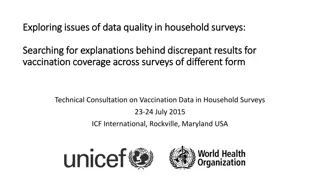Coverage-Directed Differential Testing of JVM Implementations
The paper discusses the importance of coverage-directed differential testing for Java Virtual Machine (JVM) implementations. It covers challenges in identifying JVM defects, solutions using test oracles, and examples of JVM behavior discrepancies. The study emphasizes the need for obtaining test classfiles through real-world classes and domain-aware fuzz testing to reveal compatibility issues and improve testing accuracy.
Download Presentation

Please find below an Image/Link to download the presentation.
The content on the website is provided AS IS for your information and personal use only. It may not be sold, licensed, or shared on other websites without obtaining consent from the author. Download presentation by click this link. If you encounter any issues during the download, it is possible that the publisher has removed the file from their server.
E N D
Presentation Transcript
Coverage-Directed Differential Testing of JVM Implementations Yuting Chen1, Ting Su2, Chengnian Sun3, Zhendong Su3, and Jianjun Zhao1,4 1Shanghai Jiao Tong University 2East China Normal University 3University of California, Davis 4Kyushu University 1
Outline Motivation Testing of JVMs Test redundancy Goal + Key Observations Design Evaluation Related Work and Conclusion 2
Background: JVM *.class *.jar Execution results JVM 3
JVM Testing Testing a JVM using a number of test classfiles class0 class1 Class2 4
Challenge 1: How to expose a JVM defect? Solution: Challenge: no test oracles differential JVM testing 5
An Example of JVM Behavior Discrepancy public abstract {}; HotSpot takes it as a ordinary method J9 reports a format error Cause: the JVM specification says that other methods named <clinit> in a class file are of no consequence. They are not class or interface initialization methods. A class method needs to be more strictly defined 6
Challenge 2: How to obtain test classfiles? Option 1: using the real-world classfiles Some classes can reveal compatibility issues Option 2: domain-aware fuzz testing 7
An Example of JVM Behavior Discrepancy public abstract mymethod{}; clinit More JVM discrepancies are revealed by domain-aware fuzz testing 8
Challenge 2: How to obtain test classfiles? Option 1: using the real-world classfiles Some classes can reveal compatibility issues Option 2: domain-aware fuzz testing 9
Challenge 2: How to obtain test classfiles? An infinite number of test classfiles can be created They may reveal a small number of JVM discrepancies Test redundancy Solution 2: domain-aware fuzz testing 10
Key Observation (1) A classfile can encompass intricate constraints Corner cases can be created through rewriting seeds Syntax tree Revised syntax tree 11
Key Observation (2) Equivalence class partition (ECP) saves the testing cost ECP works only if we can decide whether two tests belong to the same partition 12
Our Design: An Overview HotSpot for Java7 HotSpot for Java8 HotSpot for Java9 IBM s J9 GIJ 13
Our Design: An Overview mutation It makes the classfile mutants more representative selection testing HotSpot for Java7 HotSpot for Java8 HotSpot for Java9 IBM s J9 GIJ 14
Outline Motivation Design Mutating classfiles Selecting representative classfile mutants Selectively applying mutators Differentially testing JVMs Evaluation Related Work and Conclusion 15
mutation Mutating Classfiles selection testing 16
mutation Mutating Classfiles (2) selection testing 123 mutators are designed for rewriting the ASTs of the seeds Six mutators are designed for rewriting the Jimple files of the seeds r0:=parameter0: java.lang.String[]; r1:=<java.lang.System: java.io.PrintStream out>; virtualinvoke $r1.<java.io.PrintStream:void println(java.lang.String)>("Executed"); private Limitation: Only the JVMs startup processes can be tested The mutated program constructs/attributes may be less likely to be activated during execution 17
JVM Startup Errors and exceptions Errors and exceptions Creation and loading Errors and exceptions Execution Linking Initialization Errors and exceptions 18
JVM Startup (2) Errors and exceptions Errors and exceptions Creation and loading Errors and exceptions Execution Linking Initialization Can this class be normally executed, or at which stage some errors or exceptions can be thrown out? Errors and exceptions 19
Outline Motivation Design Mutating classfiles Selecting representative classfile mutants Selectively applying mutators Differentially testing JVMs Evaluation Related Work and Conclusion 20
mutation Selecting Representative Classfiles selection testing ECP Do two classfiles belong to the same class? Yes, if the reference JVM equally processes them HotSpot for Java9 No, otherwise 21
mutation Selecting Representative Classfiles (2) selection testing Do two classfiles belong to the same class? Seeds 7000 smts, 2300 branches HotSpot for Java9 7020 stmts, 2340 branches ? stmts, ? branches New mutant Is it representative? Several comparison criteria can be given here 22
Outline Motivation Design Mutating classfiles Selecting representative classfile mutants Selectively applying mutators Differentially testing JVMs Evaluation Related Work and Conclusion 23
Selecting Mutators Goal: to create as many representative classfiles as possible Fact: mutators are designed arbitrarily; some are effective, while some others are useless A na ve solution: to select mutators by learning from prior knowledge 24
An MCMC Sampling Method Which mutator will be selected at each step? A desired distribution: geometric distribution A has higher success rate than B, and thus it should be easier to be selected than B 0.025 0.02 0.015 The actual distribution 0.01 0.005 0 25 A 55 B 100 103 106 109 112 115 118 121 124 127 1 4 7 10 13 16 19 22 28 31 34 37 40 43 46 49 52 58 61 64 67 70 73 76 79 82 85 88 91 94 97 Proposition: The more number of representative classfiles have been created by a mutator, the more likely the mutator should be selected for further mutations 25
More Details The desired distribution Classfuzz picks up mutators at random, and then accepts or rejects the mutators by a Metropolis choice 26
Outline Motivation Design Mutating classfiles Selecting representative classfile mutants Selectively applying mutators Differentially testing JVMs Evaluation Related Work and Conclusion 27
Execution Comparison result0= jvm0(env0, c, input) result1= jvm1(env1, c, input) result2= jvm2(env2, c, input) result3= jvm3(env3, c, input) result4= jvm4(env4, c, input) A JVM discrepancy appears when resulti resultj It can either be a JVM defect or a compatibility issue 28
Execution Comparison (2) result0= jvm0(env0, c, input) result1= jvm1(env0, c, input) result2= jvm2(env0, c, input) result3= jvm3(env0, c, input) result4= jvm4(env0, c, input) A JVM defect appears when resulti resultj 29
Execution Comparison (3) result0= jvm0(env0, c, input) result1= jvm1(env0, c, input) result2= jvm2(env0, c, input) result3= jvm3(env0, c, input) result4= jvm4(env0, c, input) A JVM defect appears when resulti resultj 30
Execution Comparison (3) jvm0may miss catching some format errors 0 1 1 1 1 result0= jvm0(env0, c, input) result1= jvm1(env0, c, input) result2= jvm2(env0, c, input) result3= jvm3(env0, c, input) result4= jvm4(env0, c, input) A JVM defect appears when resulti resultj 31
Outline Motivation Design Evaluation Setup Results Related Work and Conclusion 32
Setup Coverage collection HotSpot for Java9 GCOV + LCOV At each run the coverage can be conveniently collected share/vm/classfile/ (11977 LOCs) Cost for cov. analysis: 90 secs HotSpot (260K LOCs) Cost for cov. analysis: 30+ mins Seeds 1216 classfiles in JRE 7 33
Evaluated Methods Classfuzz supplemented with a uniqueness criterion [st], [stbr], [tr] explained in the paper Randfuzz, Greedyfuzz, Uniquefuzz classfuzz randfuzz greedyfuzz uniquefuzz Mutation-based Cov. analysis Uniqueness criterion [st] [stbr] [tr] [stbr] [stbr] Mutator selection 34
Metrics RQ1: How many test classfiles can be generated? #Iterations, |GenClasses|, |TestClasses| RQ2: How effective are the test classfiles? |Discrepancies|, |Distinct Discrepancies|, diff rate RQ3: Can the test classfiles find any JVM defects? 35
Outline Motivation Design Evaluation Setup Results Related Work and Conclusion 36
Results on Classfile Generation 100.00% 30000 90.00% 25000 80.00% 70.00% 20000 60.00% 50.00% 15000 40.00% 10000 30.00% 20.00% 5000 10.00% X 0.00% 0 Randfuzz generates 20 times as many classfiles as those generated by any other algorithm Classfuzz[stbr] generates the most number of representative classfiles Classfuzz[stbr] achieves the highest success rate among all the coverage- directed algorithms 37
Results on Classfile Generation (2) Classfuzz can utilize the prior knowledge to select mutators strongly correlated randfuzz succ rate classfuzz weakly correlated 38
Results on Differential JVM Testing Classfuzz can enhance the ratio of discrepancy triggering classfiles from 1.7% to 11.9% 14.00% JVMs are compatible for most of the classfiles, but differ in processing corner cases 12.00% 10.00% 8.00% We have experienced 898 different execution paths. 107 paths were related to JVM behavior differences 6.00% 4.00% 2.00% 0.00% 1 2 39
Discrepancy Analysis (1) public abstract {}; HotSpot takes it as a ordinary method J9 reports a format error The JVM specification needs to be clarified 40
Discrepancy Analysis (2) A type casting needs to be performed JVMs take their own classfile verification and type checking polices 41
Discrepancy Analysis (3) JVMs are not compatible to access some classes 42
Discrepancy Analysis (4) More findings J9 is less strict than HotSpot because J9 only verifies a method when it is invoked, while HotSpot verifies all methods before execution GIJ can execute an interface having a main method GIJ accepts a class with duplicate fields These discrepancies can be found in a package of 62 discrepancy-triggering classes 43
Outline Motivation Design Evaluation Conclusion 44
Conclusion Problem Testing JVMs requires painstaking effort in designing test classfiles along with their test oracles Proposal: classfuzz: coverage-directed fuzz testing Test classfile generation Mutating classes and selectively applying mutators Deciding the representativeness of a classfile mutant Differential JVM testing Tool is available at http://stap.sjtu.edu.cn/ chenyt/DTJVM/index.htm 45
